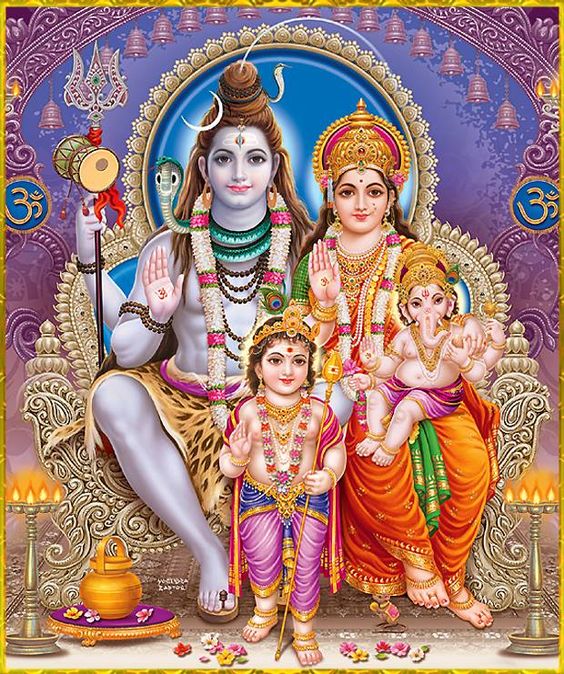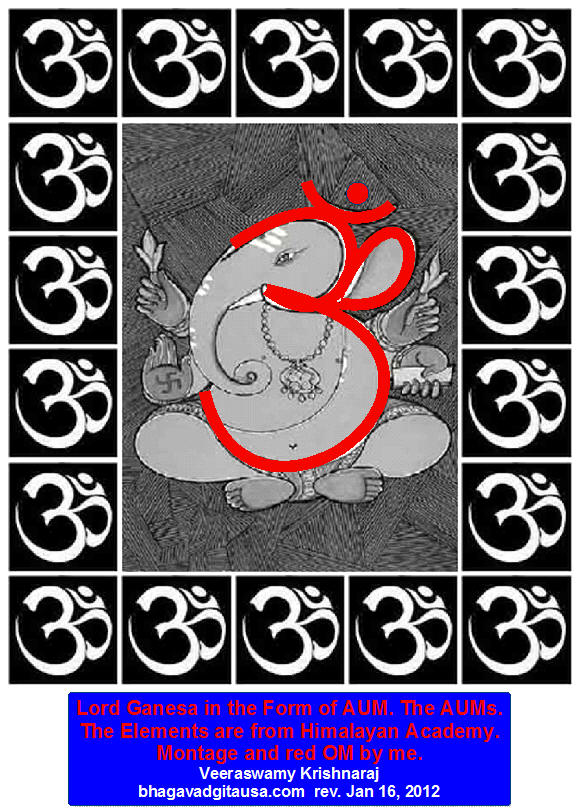Invocation of Ganesa as found in the Book "Deivaththin Kural"
Part1-01&02
Translation from Tamil to English: Veeraswamy Krishnaraj
Pillaiyar (பிள்ளையார்
=
Ganesa) Temples are ubiquitous all over Tamil Nadu. There are Pillaiyar
temples with walls, roofs, and domes (Turrets). There are Pillaiyar
idols even at the base of trees, open to the sky and the elements.
Kumaran (குமரன்)
is son (பிள்ளை).
All over India, Kumaran refers only to the second son of the divine
couple Siva and Parvati. He is Kumara-k-Kadavul (குமரக்கடவுள்).
We do not address him Kumaranar (குமரனார்),
an honorific title. We gave the honorific title only to the elder son of
Siva and Parvati.
Pillaiyar is of the form of AUM, from which the universe and beings take
origin. His elephantine face and the trunk resemble Pranava (பிரணவம்),
OM.
Though he appears to be a child, he is in the forefront in making us
raise our hands high in adoration of him. Avvaiyar
(ஔவையார்)
is the great worshiper of Ganapati. She meditated on Vinayaka in
Bhru-Madya (புருவமத்தியம்)
and composed Vinayagar Akaval (விநாயகர்
அகவல்),
Avvaiyar's all-embracing Yoga Sastra. If you committed it to memory, you
will obtain supreme spiritual knowledge (paramajñāna =
பரமஞானம்).
There is a story about Avvaiyar. Sundaramurthy Swamy and Seraman Perumal
Nayanar left for Kailasam. They wanted to take Avvaiyar with them. At
that moment, she was worshipping Viksesuvarar (விக்சேசுவரர்)
and the duo, pressing her to join them, asked her to finish the worship
expeditiously.
Avvaiyar: You go the way you chose to go. For your sake, I will not
hasten the worship. Vinayaka worship is my Kailasam.
The duo left for Kailasam. Avvaiyar completed the worship observing all
the details. At the end, Pillaiyar made his gracious presence visible (பிரசன்னம்)
to Avvaiyar, picked her up by the trunk and in one sweep took her to
Kailas. Swamy Vignesvar shows that kind of favor to his devotees.
What is the reason for breaking a coconut before Vinayaka Murthi?
Vignesvarar asked his father to sacrifice his head to him. Love of
Ganesa comes to the forefront, only when a devotee sacrifices what he
regards above all else as precious. Siva created a hard-shelled
three-eyed coconut seed in the form of his head, so the devotee can
sacrifice it to Ganesa; such a sacrifice is pure Thyakam (giving).
Tamil Nadu is the only place where the coconut is broken this way. The
broken coconut is an entitlement for the children. This truth, I learnt
from a child. In 1941, I was in Nagapattinam, observing a vow. In the
temple, it was customary to break coconuts by hundreds. The children
milled around the coconut breaking area and left no space for breaking
the coconuts. The elders admonished the children to stay away from the
place, so they could break the coconuts. One child came forward and
said, “You break the coconuts for Pillaiyar. What right you have to tell
us not to come to where you break the coconuts.
There is no deity more corpulent than Pillaiyar; the head is that of an
elephant; the stomach is humongous; the body is huge; he is known as
Sthūla Kāyar (ஸ்தூல
காயர் =
Gross body is huge); he is like a mountain. He is a little child; at
this stage, he has to eat a lot relative to his age and size, so he can
grow. The body should not be allowed to waste. A sannyasi should not be
of a big body; there is no beauty and grace, if a Sannyasi ate a lot,
and look big. As a person becomes older and aged, he or she fasts in the
night. A child does not do it. The beauty in a child is to be corpulent
(chubby) with a paunch. This child-deity shows that a child should be a
‘‘butterball.’
Pillaiyar holds a rice ball in his hand. He looks like an elephant. His
mount is a small mouse. Other deities have a bull, a horse, a bird…as
the mounts. Though Pillaiyar’s size is inversely proportional to the
size of his mount, the greatness and honor of a deity do not proceed
from the size of the mount. Because of the greatness of the deity, there
is greatness to the mount. Pillaiyar, though huge, remains light in the
hearts of his devotees.
Every living thing has a great honor in one of its own organs.
Kavari-māṉ (கவரிமான்
= Bos grunniens) has its honor in its tail, the peacock in its long,
erectile, greenish, iridescent tail. The peacock grooms and protects its
tail. The organ of honor for Pillaiyar is his tusk. He sacrificed it in
the name of writing Mahabharata with it as a writing instrument for
justice, Dharma, learning… Swamy needs no instrument as a special need.
He can use anything as an instrument, at the command of his thought. His
tusk was the weapon, when he killed an Asura; the same tusk served as a
pen for writing Mahabharata.
The objects, which never stops fascinating us, are the moon, the ocean,
the elephant… We never get a feeling of surfeit looking at them and
enjoy their presence. As we look at his elephantine form, we are
immersed in joy; that is bliss; that is Bliss Principle (ஆனந்த
தத்துவம்);
it is the principle of Insatiable Delight. He was born in bliss.
Pantāsuran was a demon. Parvati attempted to destroy him. Pantasuran
deployed obstructive forces, so Parvati could not approach him. Siva
looked at Parvati with ecstatic amorousness. Parvati instantly gave
birth to the joyful child, Pillaiyar, who smashed all the obstructive
weapons and helped her in destroying the demon. He is the son of
Parvati and Paramesvara. He manifested (ஆவிர்ப்பவித்தல்)
himself from the original source (மூலம்);
that is why we call him Pillaiyar.
When you worship any deity, you have to obtain favor from Vinayaka, so
the endeavor would face no obstruction or impediment. Ganapathiyam is
the sect that regards Ganesa as the primary god of worship. Mahavishnu
was the teacher, advising us to do the
tōppi-k-karaṇam (தோப்பிக்கரணம்
=
Punishment or exercise requiring a person to take hold of his ears with
his hands and sit and stand alternately). There is a story behind this.
Pillaiyar, the son-in-law of Vishnu, in an act of play, took away the
discus of Vishnu and put it in his mouth. It is impossible to wrest
anything from his hands. His strength is immense. Threat of punishment
does not work with him. Vishnu thought he could get it back, if it fell
from his mouth. Vishnu devised a stratagem. He held his ears with his
four hands and danced. Vinayaka rolled over the floor laughing. The
discus fell, and Vishnu took possession.
Any endeavor would come to a fruitful conclusion, only when Vignesvara
manifests a favorable disposition. Let us worship him, offer Puja and
live happily with no impediments.


